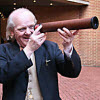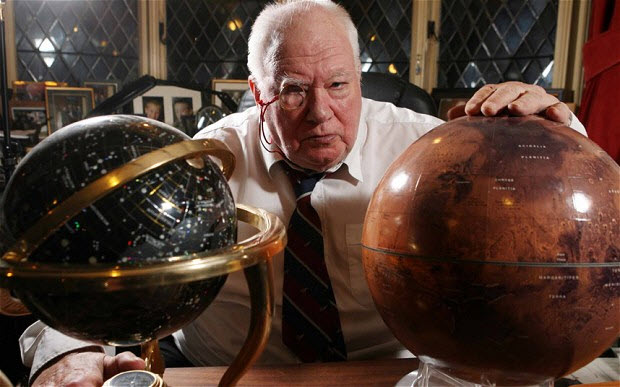
Dr Alan Chapman
(Oxford University)
This was Dr Chapman’s personal homage to Patrick, not his life story as such, but an attempt to compare his likeness with other great science communicators, publishers and educators of the last 300 years.
Alan began in the 17th century, with Dr John Wilkins (1614-1672) a clergyman fascinated by life on other worlds and one of the founders of the Royal Society. In 1638 he had written an account of how you might travel to the Moon on a flying chariot. A man very much in the mould of Patrick, thought Alan. The next successor was Benjaman Martin (1704-1782) a lexicographer who compiled one of the early English dictionaries, the Lingua Britannica Reformata (1749). Was also a renowned lecturer on science and maker and collector of scientific instruments.

Patrick Moore: Who's he like? ... Like lots of people, says Chapman. Image Credit: Paul Grover
Dr Chapman suggested that both Sir Humphrey Davey (1778-1829) and Michael Faraday (1791-1867) were in some or many ways akin to Sir Patrick. Davey displayed that characteristic enthusiasm and energy in all his pursuits and had a highly imaginative mind, indeed the poet Coleridge declared that if he "had not been the first chemist, he would have been the first poet of his age". At times rather sanguine and of irritable temperament, in spite of his ungainly exterior and peculiar manner, Davey’s gift of exposition and illustration won him extraordinary popularity as a lecturer, his experiments were ingenious. Davey’s dominating ambition, to achieve fame, was certainly opposite of Patrick’s character, however, his frankness and slightly careless observances of etiquette do though bear similarities to Patrick’s nature. Davey’s protégé, Michael Faraday, could be considered more akin to Patrick. Faraday, who contributed so much to various fields in science, was an excellent experimentalist who conveyed his ideas in clear and simple language, not unlike Patrick. The Royal Institute lectures were instigated by Faraday, who in his later life was regarded as what would now be termed a ‘national treasure’. Indeed Queen Victoria granted Faraday a grace and favour apartment at Hampton Court.
Alan’s next choice was Sir Robert Ball, (1840-1913) the genial Irish astronomer and orator, celebrated for his popular lectures on science; bringing science to the masses. He gave an estimated 2500 lectures between 1875 and 1910 in towns and cities across Britain and Ireland lecturing to an estimated one million people, all before the media age. He also delivered three Royal Institute Christmas lectures. Patrick insisted that his grandfather met and knew Ball. Dr Chapman argued that during the early and middle part of the 20th century, the English astronomer, physicist, and mathematician, Arthur Eddington (1882-1944) was the only populariser of Science on a par with Patrick.
Dr Chapman spent the last third of the lecture reflecting on Patrick himself. Alan had come to know Patrick over the course of several decades, through work in the media, on the lecture circuit and many other associated functions, meetings and events. The Moore’s were a military family, indeed Patrick once told Alan he was related to Sir John Moore of Coruna, in the Peninsula wars of the Napoleonic age. Dr Chapman was always a little sceptical of this. Indeed Alan suspected a few of Patrick’s tales and recollections may have been slightly embellished as the years went by. Dr Chapman was even unsure as to the validity of some of Patrick’s war memories he sometimes alluded to. ‘You never quite knew with Patrick’ Alan said.
What cannot be doubted however was the passion Patrick had for astronomy, be it observing, writing about, presenting or giving lectures, Patrick always had something to say – normally very fast. Dr Chapman fondly remembered following his marriage to his wife Rachel in1991, Patrick invited them down to his house; Farthings, in Selsey, for a few days. After dinner on the first night, Patrick decided to do some lunar observing asking Alan to join him. They duly disappeared into the garden leaving Rachel to retire to bed. During the course of the observations, which lasted into the small hours of the morning, they saw a TLP; Trans Lunar Phenomena – a bright streak, perhaps out-gassing of some kind, emanating from near the lunar limb. Such events have been seen occasionally, but to actually witness one with Patrick was something Alan will remember forever.
Patrick was extremely generous, always encouraging, he had time for any young astronomer who wanted his advice. Patrick would spend hours replying to letters and requests in person. Patrick was quite a skilled musician (his mother had been a trained opera singer) and he had learned to play the xylophone. He had a love of cricket, playing in the local team for many years. Alan also saw firsthand the love Patrick had for Cats, and he doted on his own two; Ptolemy and Jeannie who even had their own large self contained run in the garden. Following the death during WW2 of Lorna, Patrick’s only real love, Alan thought ‘they were the children Patrick never had’.
As Patrick’s physical health slowly deteriorated, he found it increasingly difficult to make long journeys, so that eventually the Sky at Night was filmed from Farthings. Alan believed this added a homely feel to the programme which everyone who visited found very comforting. There was always a constant stream of friends and colleagues calling round, even when Patrick became fully housebound, something he hated, he always had time and continued his writings until the end.
Dr Chapman finished by reminding us just how very few people of Patrick’s persona have so endeared themselves to the general public over such a long period of time. Patrick crossed that threshold - observer, presenter, writer, lecturer, national treasure. His like are few and far between.
- Log in to post comments

